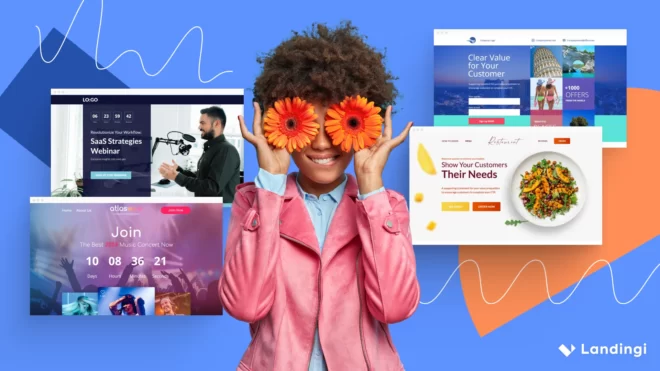The main goal of each landing page, regardless of industry, is to deliver high conversion rates – does your landing page convert visitors as well as it could? Discover how landing page testing can elevate your conversion in our 8-step guide, which follows:
- Objective setting
- Hypothesis formation
- Variant creation
- A/B or multivariate testing
- Traffic allocation
- Data collection and analysis
- Implementation and optimization
- Repeating the process
Note that A/B testing of landing pages can increase conversions by up to 300%, according to a HubSpot report. The improvement varies depending on the industry, target audience, and the specific changes tested, but this data proves how conversion optimization affects successful landing pages.
Read on and become familiar with landing page A/B testing and other methods to create a successful landing page for your business.
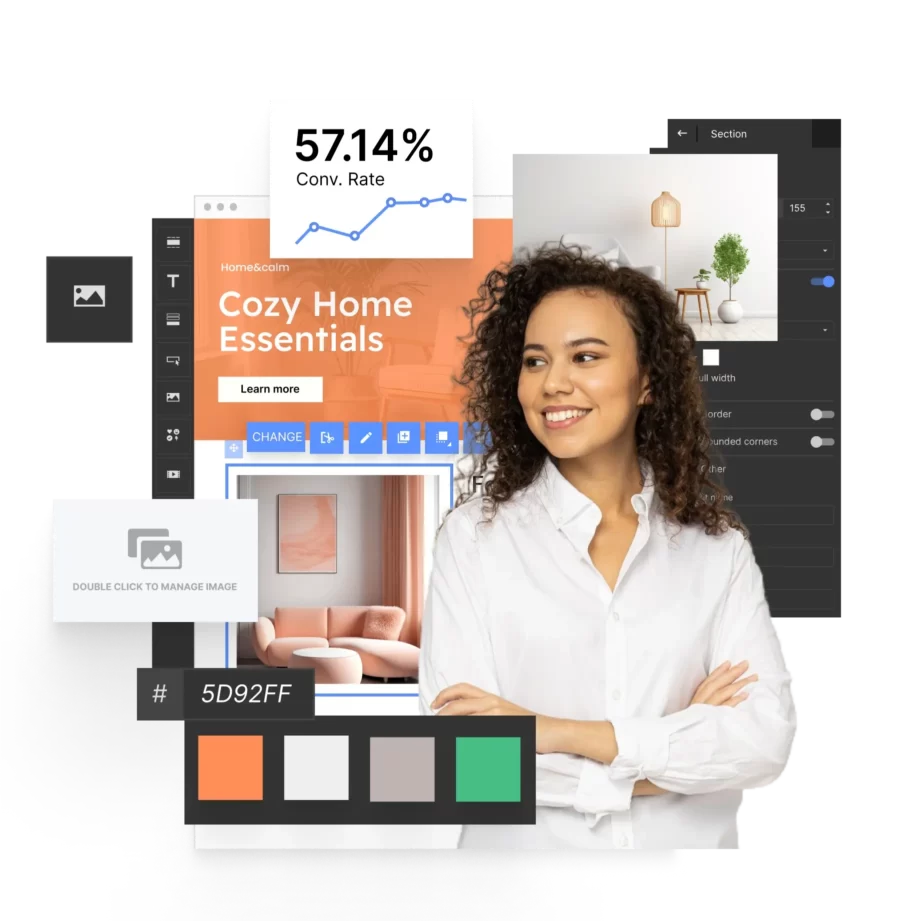
What Is Landing Page Testing?
Landing page testing, a crucial aspect of conversion rate optimization, involves experimenting with different versions of a landing page to determine which are most effective in converting visitors into customers or leads. Testing involves the essentials of a landing page, such as layout, content, or design elements, but also includes general loading speed.
This process typically uses A/B testing or multivariate testing methods. In split testing, two versions of a page (the original and a variation) are compared, while multivariate testing assesses multiple variables simultaneously.
The objective is to identify which changes increase user engagement, sales, sign-ups, or other desired actions on the page. This kind of testing is data-driven and relies heavily on user behavior analysis to make informed decisions about web design and content.
Increase conversions with A/B testing—optimize your landing page on Landingi!
What Is the Landing Test Method?
The Landing Test Method, often referred to as landing page testing, is a systematic approach used to improve the effectiveness of a website’s landing page.
Regular testing allows for ongoing optimization. Even minor, incremental improvements in conversion rates can have a significant impact over time. By consistently refining and adjusting elements based on test results, you can continuously enhance the user experience and effectiveness of the landing page.
You don’t have to search for complex tools that cover only some of the features needed to optimize your landing page. Landingi is a multifunctional platform that provides an essential toolkit not only to craft landing pages but also to run A/B tests, track user behavior, analyze gathered data, and implement optimizations to drive higher conversion rates.
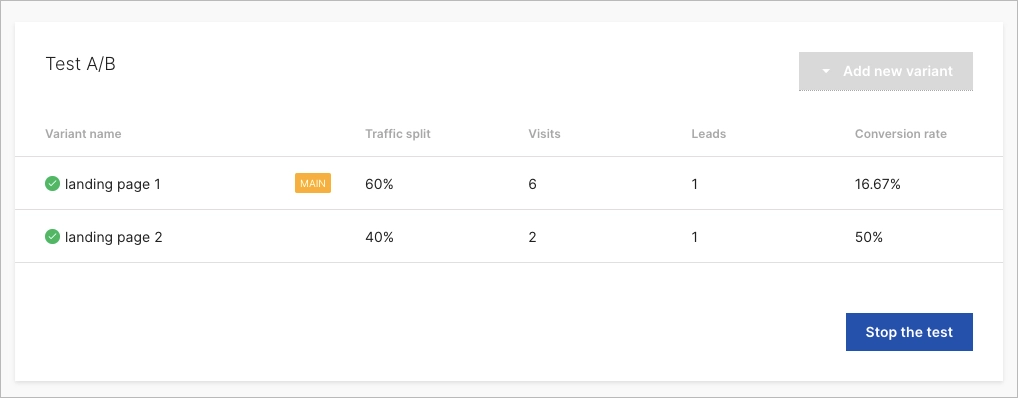
Remember that frequent testing generates a larger pool of data, providing deeper insights into user behavior and preferences.
The landing test method involves the 8 key steps mentioned in an entry section of the article. This procedure, examined in detail below, is highly data-driven and relies on actual user responses rather than assumptions, making it a powerful tool for improving website conversion rates and user experience.
Find out what works—test and optimize your landing page with Landingi!
8 Steps to Landing Page Testing for Conversion Rate Optimization
Let’s start your landing page testing journey – check out the detailed 8-step guide below and learn how to optimize your landing page for conversions.
The instructions involve the following:
- Objective setting
- Hypothesis formation
- Variant creation
- A/B or multivariate testing
- Traffic allocation
- Data collection and analysis
- Implementation and optimization
- Repeating the process
1. Objective setting
As the first step, you should set the main objectives for the landing page. Without pointing out the aims, you can’t implement adequate testing. Think about objectives in the following 5 essential points:
- Clarifying business goals – align the landing page objectives with broader business goals. Whether it’s increasing product sales, generating leads for services, promoting an event, or raising brand awareness, the landing page should serve as a direct line to these overarching objectives.
- Defining specific conversion goals – those vary widely depending on the nature of the business and the purpose of the landing page. This could include direct sales or sign-ups, lead generation through form submissions or contact inquiries, downloads of digital products, subscriptions to newsletters or registration for the web, etc.
- Setting quantifiable targets – establish measurable targets for your business goals. For example, aiming for a specific percentage increase in sign-ups or a targeted number of downloads. These quantifiable targets help in evaluating the success of the landing page tests.
- Understanding the audience – objectives should be set with a clear understanding of the target audience. Knowing who the visitors are, what they need, and what motivates them is crucial for setting relevant and achievable goals.
- Benchmarking current performance – analyzing current landing page performance provides a baseline against which to measure. It’s important to know the existing conversion rate and other relevant metrics to track improvements accurately.
Precise objective setting marks the initial step in testing landing pages. What conversion goal do you aim to achieve for your target audience? Are you looking to increase sign-ups, generate more leads, or boost sales?
Identifying problems through methods such as surveys, customer interviews, and data analysis will help you define your objectives.
Maximize your conversion rate—start testing your landing page with Landingi!
2. Hypothesis formation
The second step is to create a hypothesis, which involves making a data-based guess about what changes could improve your landing page’s performance. This is not a random guess but rather a calculated assumption based on your understanding of your audience, your product, and your past performance.
You might hypothesize, for instance, that changing the wording of your call-to-action button will increase click-through rates or that adding customer testimonials will boost conversions. Your hypothesis should be data-driven and based on research and insights from tools such as:
- Google Analytics
- Customer interviews
- Surveys
- Heat maps
- User testing
You can also choose a multifunctional platform, like Landingi with built-in EventTracker, to follow real data about micro-conversions. It shows the potential of your page and gives insights about improvement areas.
Get actionable insights—test different versions of your landing page on Landingi!
3. Variant creation
The third step is about developing page variants for testing. Each variant should include a single change to isolate its effect on conversions. Create separate versions for each element you want to test. This could be a different headline, image, or call-to-action button.
When creating these variants, the change should be significant enough to impact user behavior potentially. For instance, when conducting variant creation for landing page testing, consider the following:
- If you’re testing headlines, the alternate headline should be distinct from the original in terms of messaging, tone, or value proposition.
- If you’re testing images, consider using visuals that are different in style, color scheme, or subject matter.
- As for call-to-action buttons, you could experiment with different colors, text, or placement on the page.
By making meaningful changes in these variants, you increase the likelihood of discovering impactful insights about your page performance.
Boost conversions by testing key elements—use Landingi’s testing tools today!
4. A/B or multivariate testing
The fourth step leads to conducting A/B or multivariate tests on your variants, which will help you determine which version of your page performs best. At this stage, you should choose the adequate tool to start testing. The best option is to find a landing page builder that delivers features for running tests and allows gaining data across different test elements.
This critical phase involves pitting your original design against the new variants to see which one resonates more with your audience.
A/B testing is a straightforward process where you change one element on your page at a time and measure its impact on your micro-conversions or the main conversion.
On the other hand, multivariate testing is a bit more complex, allowing you to test multiple changes simultaneously and understand the combined effect of these changes. Both these testing methods provide valuable insights and help you make data-driven decisions for conversion optimization.
Improve your landing page with data—run tests easily on Landingi!
5. Traffic allocation
The fifth step is to direct traffic toward variants. It’s a vital part of the split testing process. This stage is crucial because the distribution of traffic can significantly influence the results of your tests. For instance, if one variant receives more traffic during peak hours, it might perform better simply because of the increased exposure. To avoid such biases, it’s essential to distribute traffic evenly between the variants.
Furthermore, the amount of traffic allocated to each variant can also impact the time it takes to reach statistically significant results. If one variant receives a small fraction of the total traffic, it might take much longer to gather enough data for reliable conclusions. Therefore, it’s important to use tools like A/B & Split Test Duration Calculator to ensure that you allocate enough traffic to each variant for timely and reliable results.
Landing page split testing doesn’t have to be complex. If you’re not advanced in this field, Landingi provides all the necessary features in one intuitive tool, invented not only to create but also to test landing pages.
See what drives conversions—test and improve your landing page with Landingi!
6. Data collection and analysis
In the sixth step, you jump to gathering and dissecting data from your tests, which will aid in verifying the accuracy of your hypothesis. This stage is all about data analysis, where you’ll be delving into the numbers and statistics generated by your tests. When you collect data, you’re not just looking at the raw numbers, but you’re trying to understand the story they tell about user behavior on your landing page.
You’ll be looking at metrics such as the following:
- Bounce rate
- Time spent on the page
- Click-through rates
- Conversion rates
This data will give you insights into how users are interacting with the different elements on your page and how those interactions are affecting conversion.
In addition to these quantitative data, you might also be gathering qualitative data through methods like user surveys or interviews. This can provide more context about why users are behaving in certain ways on your page.
Once you’ve gathered all this data, the next step is to analyze it. You’ll be looking for trends and patterns that can help you understand what’s working and what’s not. This might involve statistical analysis or A/B test analysis to determine the most effective version across multiple variations.
Ultimately, the goal of this step is to use the data you’ve collected to either confirm or refute your hypothesis.
If the data supports your hypothesis, then you know you’re on the right track. If not, then it’s back to the drawing board to come up with a new hypothesis to test. Either way, you’re gaining valuable insights that will help you optimize the page and increase conversions.
Documenting learnings from each test will help inform future tests and optimization strategies, so choose the tool that saves historical information.
Optimize every element—run landing page tests using Landingi’s platform!
7. Implementation and optimization
In the seventh step of your landing page experiment, once the most effective variant is identified, proceed to apply this version to your original page. This is a crucial part of the process where your testing efforts begin to bear fruit. The variant that has performed the best during your testing phase is now ready to be presented to your audience on a larger scale.
It’s like unveiling a new and improved product, but in this case, it’s your page that has been enhanced. This should ideally lead to better user engagement, higher conversions, and, ultimately, increased revenue. However, it is important to remember that this is not the end of your optimization journey. The digital landscape is constantly evolving, and so are user preferences. Therefore, even after you’ve implemented the winning variant, it is important to keep monitoring its performance and be ready to test new variants as needed.
Increase conversion rates by testing your landing page—get started with Landingi!
8. Repeating the process
As for the last step, remember that testing isn’t a one-off task. It’s an iterative process that requires frequent testing for continuous improvement – this is the landing page testing process.
Think of it as nurturing a garden – you don’t just plant the seeds and walk away, expecting everything to flourish on its own. You need to water the plants, prune them, and check them regularly for pests or diseases. Similarly, your page needs constant attention and care.
By continuously testing, you can adapt to changing user preferences, industry trends, and technological advancements.
It’s about staying agile, making informed decisions based on real data, and never resting, even when you see positive results. You may find that a change that worked wonders a few months ago is no longer effective or that user behavior has shifted in a way you didn’t anticipate. That’s okay – it’s all part of the process. The key is to keep learning, keep testing, and keep striving for that ever-elusive perfect conversion rate.
Utilizing a landing page testing software can greatly enhance this process. A regular cycle of testing ensures your page remains current, providing you with a competitive advantage in your industry.
Test different designs and improve your results—start with Landingi today!
4 Landing Page Testing Examples
To gain a practical understanding of page tests, consider the 4 real-world examples of testing ideas on web pages:
- Value proposition testing
- CTA testing
- Copy length testing
- Form testing
1. Value Proposition Testing Strategy
One of the most critical elements of each page is its value proposition. This is what distinguishes your offering from that of your competitors. It’s the unique selling point that makes your product or service stand out in the crowded marketplace.
The value proposition is not just about stating what your product does, but rather, it’s about explaining how it solves a problem, meets a need, or provides a benefit. In other words, it’s about showcasing the unique value that your product or service brings to the table.
For example, on how USP testing impacts conversions, Scandiweb achieved a 35% increase in Click-Through Rate (CTR) by testing the value proposition on their homepage, according to Qualaroo case studies.
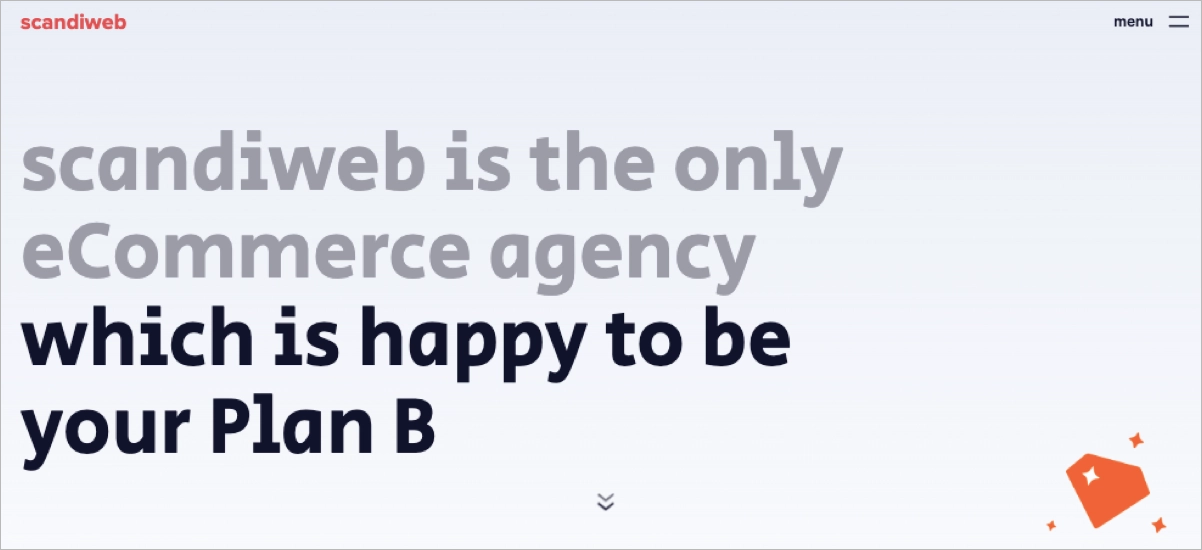
What’s noteworthy is that each page can feature a distinct Unique Selling Proposition (USP) tailored to various factors, such as:
- Identifying the specific target audience for each page.
- Addressing the unique needs, preferences, concerns, and challenges of the customers on that particular page.
- Highlighting the unique features and strengths of your company.
- Outlining the benefits of the product and the value these benefits bring to the customers.
Based on these, you can test different value propositions to find the most effective one that impacts high conversions. With Landingi’s drag-and-drop builder, anyone can create beautiful designs without coding, so you can be sure you will find the best way to show your value proposition.
Run experiments to see what converts—build and test on Landingi!
2. CTA Testing Strategy
The call-to-action (CTA) on your page is another crucial element to test. A button that encourages visitors to take the desired action is the point where they convert, so it’s up to you to find its best version and affect conversions.
During CTA testing, you can experiment with its:
- Placement – you can test CTAs in different page areas, experiment with repeating buttons in a few sections, or check out if a stick bar with CTA works better.
- Size – you may think the bigger is better, but the best option to ensure it is to run split tests for different sizes.
- Color – test various versions with contrasting colors or experiment with color psychology.
- Shape – check out which shape of button drives higher conversions.
- Message – experiment with CTA text, use different tones of voice, and test various phrases.
A great example of how CTA testing can affect higher conversions is a case study of MOZ, which boosted monthly leads for a client’s website by 148% simply by modifying the copy of the call-to-action (CTA).

Enhance user experience and conversions—test your landing page on Landingi!
3. Copy Length Testing Strategy
The length of the copy on your landing page can significantly impact its effectiveness. It’s a delicate balancing act. Depending on data-driven hypotheses, too little information may leave your visitors with unanswered questions, causing them to bounce. On the other hand, too much information may overwhelm your visitors and deter them from taking the desired action.
Copy length testing involves experimenting with different lengths and structures of your content to find the optimal balance. You have to find out if shorter, succinct bullet points and infographics are more effective or if your audience prefers long-form, detailed explanations.
Think over if you need multiple paragraphs to convey your value proposition. Maybe you can use simple, short content sections, infographics, or short video content instead of huge blocks of text. There is a space for experimenting. In this strategy, you can test different versions of your landing page with varying lengths of copy.
A key aspect of copy length testing is tracking user engagement metrics, such as time spent on the page and scroll depth, which can be easily done within the Landingi tool. These metrics can provide insights into how users are interacting with your content and whether they are reading it fully or losing interest partway through.
An example of the content length impact on conversions is Crazy Egg, a brand that managed to amplify its landing page conversion rate by a whopping 363%, simply by transitioning from short-form to long-form content on its page.
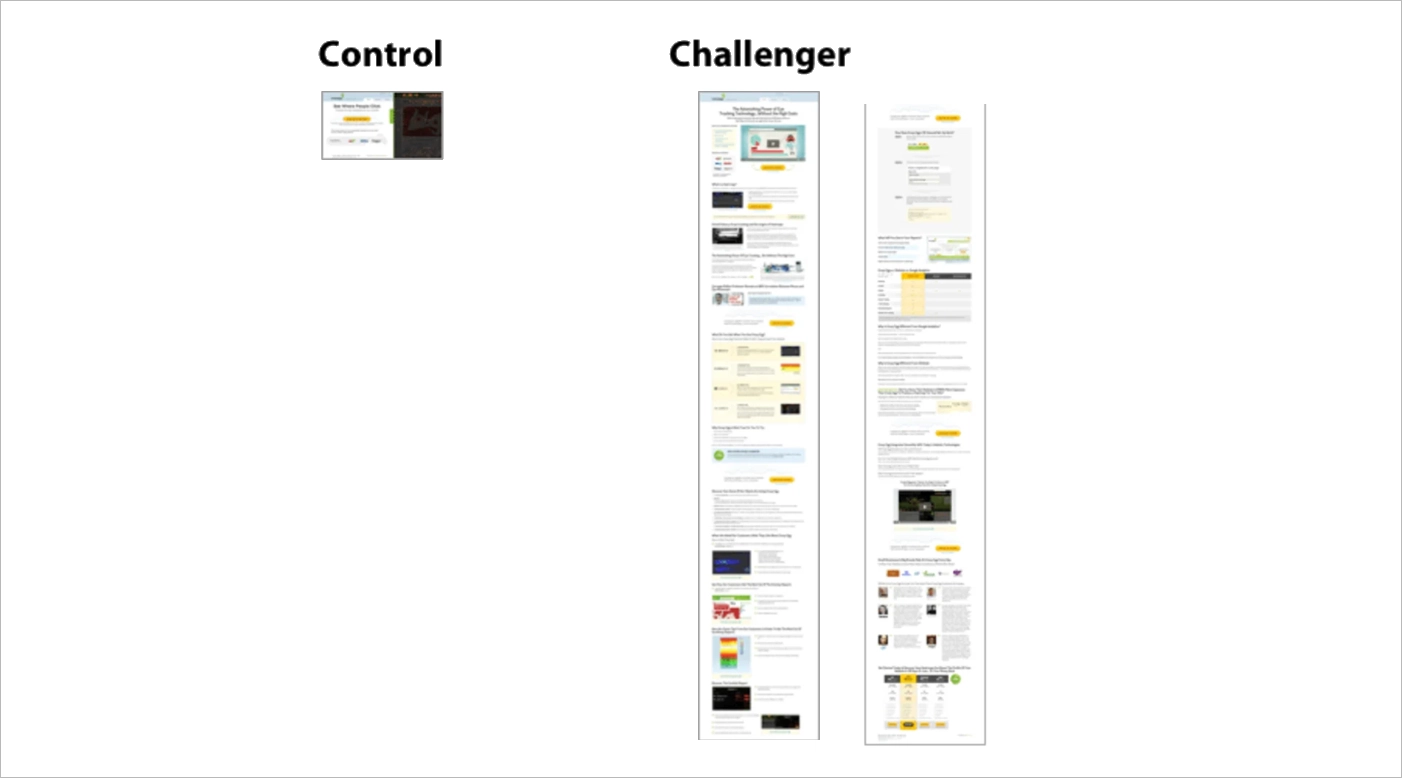
Remember, the goal is not necessarily to find the shortest or the longest possible copy but to find the copy length that most effectively communicates your value proposition and prompts your visitors to take action.
Discover what converts best—test variations of your landing page with Landingi!
4. Form Testing Strategy
Form testing is an essential part of web page optimization. Opt-in forms are the gateway to lead generation, so it’s crucial to ensure they are as effective as possible. You can experiment with various elements of your form, such as:
- Form length – test short form against long form to see which one performs better. While shorter forms may lead to more submissions due to their simplicity, longer forms might generate higher-quality leads.
- Field types – test different types of input fields (text, dropdown, checkbox, etc.) to see which ones your audience prefers.
- Form call-to-action – the text on your form’s submit button can significantly impact conversions. Experiment with different phrases to find the most compelling one.
- Form design – the form layout, including its color scheme, font, and shape, can also affect its performance. Try different designs to see which one resonates best with your audience.
By running form tests, you can identify any potential barriers to conversion and take steps to eliminate them.
Remember, the goal is to make the form-filling process as easy and intuitive as possible for your visitors.
The 4 main mistakes may contribute to the abandonment of lead forms:
- Requesting personal information such as gender and birthday,
- Requiring all form fields to be filled,
- Forms that are not responsive to different devices,
- Excessive number of fields or questions in the form.
With this knowledge, you can create optimal types of forms for testing their effect on landing page conversions.
Improve conversion rates through data-driven tests—start on Landingi!
What Is the Best Landing Page Testing Tool?
The best testing tools are those that provide automated features for not only testing but also creating and editing landing pages, tracking user behavior, and gathering all data for analysis. The selection of an optimal landing page testing tool relies heavily upon your or your business’s needs and objectives.
Highly recommended for small businesses with a budget is Landingi, which is one of the best testing tools. This platform is particularly beneficial for businesses that are just starting out with page optimization. Thanks to its ease of use, the tool is an excellent choice for those who may not have extensive technical knowledge.
Landingi offers all necessary features, including robust A/B testing and targeting tools. Moreover, it provides a variety of templates and customization options, allowing businesses to create landing pages that truly reflect their brand. Its analytics feature with built-in EventTracker also makes it easy to track the performance of your landing pages, providing valuable insights that can guide your optimization efforts.
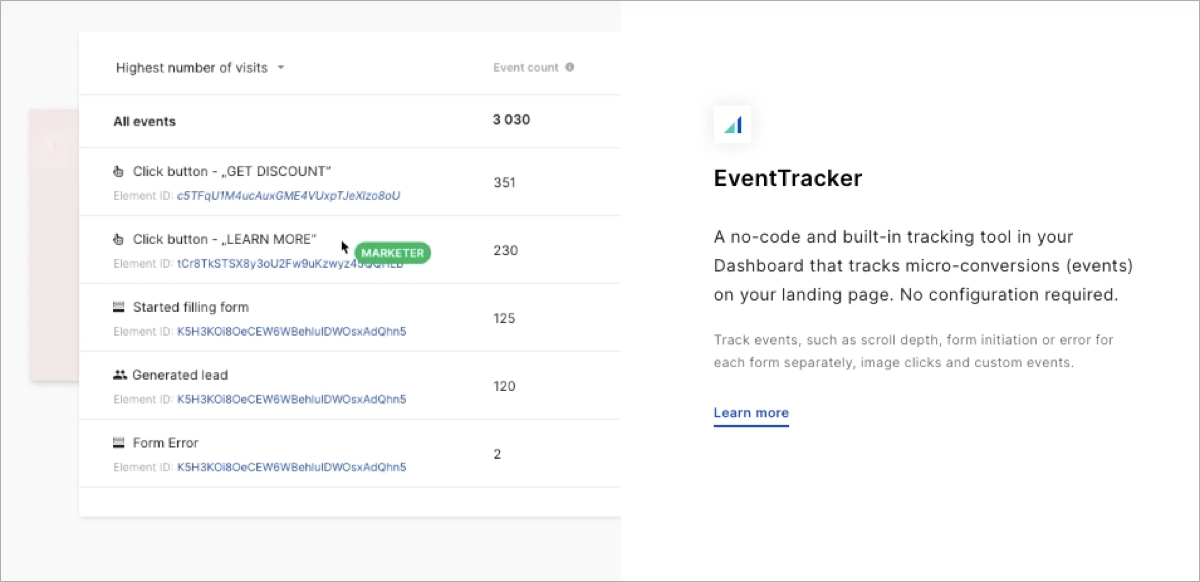
In short, Landingi is a comprehensive, budget-friendly solution for small businesses looking to improve their page performance.
However, if your primary need is to understand user behavior and optimize landing pages, Landingi, with its detailed analytics and tracking feature, can be an excellent choice. Remember, the best tool is the one that meets your specific needs and fits within your budget.
Optimize your landing page for maximum conversions—test with Landingi now!
How to Write Test Cases for Landing Page?
To create test cases for the landing page testing strategy, you need to follow 3-step instructions:
- First, identify the objectives of the web page to ensure the testing aligns with the intended outcomes.
- Next, determine the specific multiple landing page elements that need to be tested, such as headlines, images, forms, CTA buttons, and links. Create variants of these elements for testing, and set up a testing environment that closely mimics the live environment to ensure accurate results
- Finally, document all test cases clearly, including the following:
- The purpose of the test,
- The element being tested,
- The expected outcome,
- Any specific instructions for executing the test.
Your test cases should cover both functional and visual aspects to involve the complete user experience on the landing page.
Once you figure out which version is the most effective, you can implement changes on the original page.
Ready to boost conversions? Test and refine your landing page with Landingi!
What is Landing Page Speed Testing?
Landing Page Speed Testing refers to the practice of assessing how quickly a webpage loads. It is a crucial aspect of landing page optimization as it directly impacts the user experience. Fast-loading pages improve user engagement, increase conversions, and reduce bounce rates.
In this process, different elements of the webpage are analyzed to identify any factors that may be slowing down the page load time. These could include large image files, unnecessary plugins, inefficient code, or server issues.
To conduct speed tests and reach statistical significance, use tools like Google PageSpeed Insights. It provides valuable insights and actionable recommendations to improve page load times.
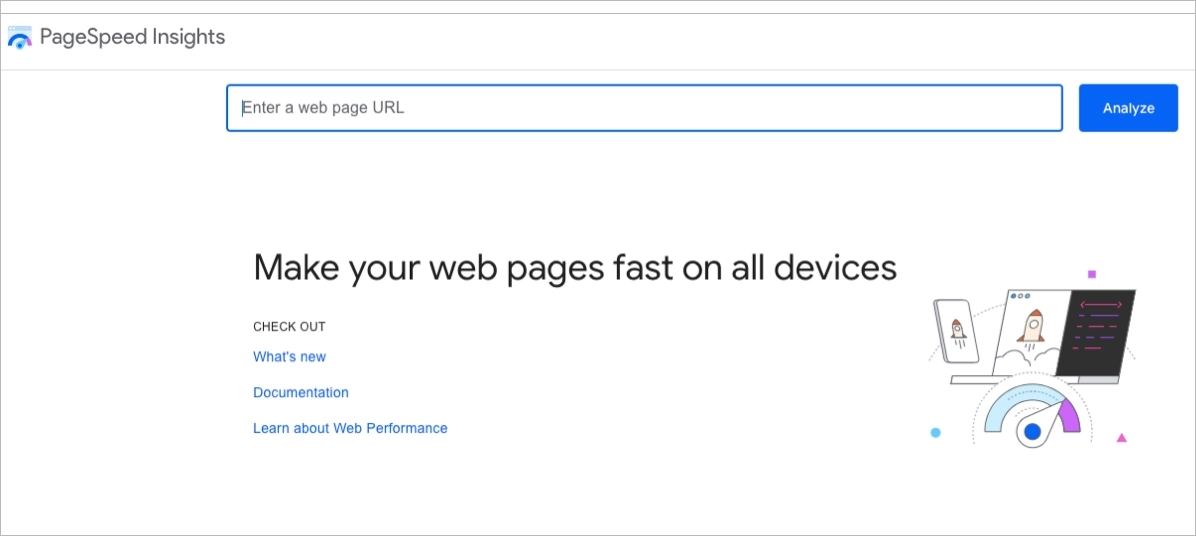
The importance of the loading speed lies in the fact that heavy pages tend to load slower, negatively impacting the user’s experience. Slow-loading pages can lead to users abandoning the page before it fully loads, leading to higher bounce rates. In turn, this can negatively affect your site’s SEO ranking, as search engines prioritize sites that offer a smooth, efficient user experience. Therefore, it’s essential to keep your pages light and optimized for quick load times.
Improve performance with landing page tests—start testing with Landingi today!
Key Takeaways
Conducting landing page tests is a pivotal part of your marketing strategy, involving experimenting with different elements on the page. The 8 steps to increase conversion within landing page testing are the following:
- setting objectives,
- forming hypotheses,
- creating variants,
- conducting A/B or multivariate testing,
- allocating traffic,
- collecting and analyzing data,
- implementing the winning variant, and
- repeating the process.
The process is data-driven and relies on actual user responses rather than assumptions. Testing tools like Landingi can greatly enhance the process by providing features for creating, testing, and analyzing desktop landing pages, as well as for mobile devices.
Key elements to test on landing pages include:
- the value proposition,
- call-to-action (CTA),
copy length, - images and videos,
- forms,
- social proof elements,
- contact details,
- loading speed.
The best landing page testing tool depends on your specific needs and budget, but Landingi is a comprehensive, budget-friendly solution for small businesses.
Keep in mind, that landing page testing isn’t a sprint – it’s a marathon. And the finish line? Well, it keeps moving. But that’s what makes it an exciting, dynamic process that can lead to significant improvements in your conversion rates over time.



